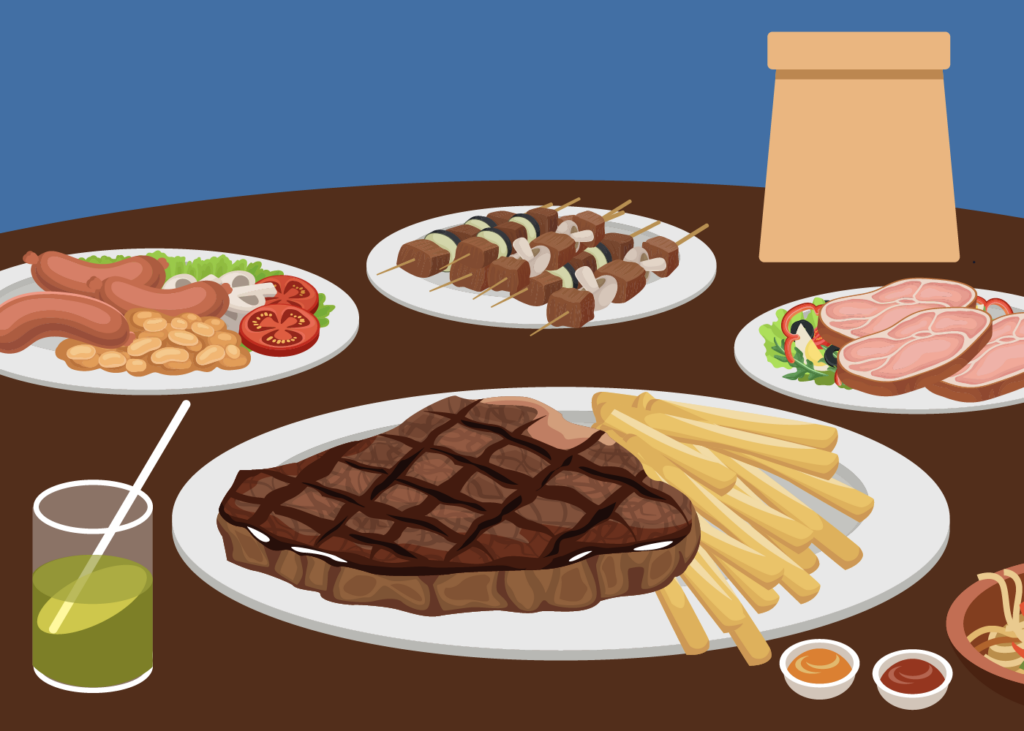Ever wonder why something as delicious and rich in protein as red meat could threaten your kidney stone prevention efforts? It all comes down to its purine content! Whether you’re a meat-lover or a curious stone former, join us as we explore the science behind red meat.
What are purines?
Purines are natural substances, made of carbon and nitrogen atoms1. They can be found in high quantities in both plant-based and animal-based foods. These include red meats, seafoods like shellfish and sardines, as well as vegetables like spinach and asparagus2.
What does any of that have to do with kidney stones?
As purines break down in your digestive system, they transform into uric acid3. Too much uric acid can make your urine more acidic4. Once your urinary pH falls below 5.5, uric acid can start to form solid crystals instead of remaining as soluble ions5. Over time, these crystals can accumulate and develop into uric acid stones5. To make matters worse, low urine pH can also contribute to calcium oxalate stone formation.
In fact, a study conducted by the Renal Division of St. Michael’s Hospital at the University of Toronto found 67% of uric acid kidney stone formers had a urinary pH of less than 5.5 for at least 12 hours a day! In contrast, non-kidney stone formers had an average urinary pH of around 6.86.
High intake of protein-rich foods like red meats has also been closely associated with increased urinary calcium excretion. Recent findings have shown that maintaining a diet rich in protein causes an accumulation of uric acid in the urine, triggering a rise in urinary calcium levels7. With more free calcium ions in the urine, the likelihood of these ions binding with oxalate increases8. As a result, you may be at a higher risk of forming calcium oxalate stones.
What should I do then?
Cut back on the red meat! Red meat has become a staple in the American diet and is consumed far more often than other high-purine foods like shellfish. To offer some perspective, the typical American consumes around 111.5 lbs of red meat9 a year, as compared to just 20.5lb of shellfish10!
What exactly is red meat?
Red meat is generally defined as meat from mammals such as cattle, pigs and goats11. Examples of red meats include beef and pork11.
On the other hand, common variations of white meat include poultry like chicken and turkey12.
How can I identify red meat from white meat?
Differentiating red meat from white meat can be a bit tricky if you’re not sure what to look out for! Here are some handy tips to guide you:
- Look at the color
Generally, red meat has a deeper, dark red color when raw. This is because red meat contains higher content of myoglobin, which is a protein found in muscle tissues13. The redder or darker the shade of the meat, the higher the myoglobin content13.
- Consider the source
Red meat typically comes from mammals11, as they utilize more red muscles for extended activity14. If you’re dining out, be sure to ask the server what kind of meat you’re eating. If it’s a mammal, it’s mostly likely red meat.
- Check the fat content
Red meat tends to have more marbling, which are streaks of fat that give it a richer flavor15. Be sure to keep an eye out for the fine flecks of fat that appear within the meat15. If you see any, the dish likely contains red meat.
What if I miss the taste of red meat?
You don’t have to go cold turkey to stay kidney stone-free! Find a delicious balance by substituting red meat with white meat in some of your favorite dishes.
Here are some options we think you’ll love16,17,18:
| Swop Out | Swop In |
|---|---|
| Spaghetti Bolognese | Chicken Bolognese |
| Beef and Pork Meatballs | Teriyaki Chicken Meatballs |
| Beef Hamburgers | Air Fryer Turkey Burgers |
| Beef Tacos | Gluten-Free Fish Tacos |
| Pork Skewers | Fish and Vegetable Skewers |
| Grilled Steak | Grilled Chicken Steak |
Conclusion
Indulging in red meats too often may put you at risk of developing kidney stones. But don’t worry, just by being mindful of your red meat intake and making simple changes can help you manage your purine levels. Try out our tips today and trust us — your kidneys will thank you!
Sources:
- Gout diet: What’s allowed, what’s not. Mayo Clinic. (n.d.). Retrieved from https://www.mayoclinic.org/healthy-lifestyle/nutrition-and-healthy-eating/in-depth/gout-diet/art-20048524
- Fumagalli, M., Lecca, D., Abbracchio, M.,P. Ceruti, S. (2017). Pathophysiological Role of Purines and Pyrimidines in Neurodevelopment: Unveiling New Pharmacological Approaches to Congenital Brain Diseases. Frontiers. Retrieved from https://www.frontiersin.org/articles/10.3389/fphar.2017.00941/full#:~:text=Purines%20act%20as%20metabolic%20signals,et%20al.%2C%202006).
- Kamel, K., S., Cheema-Dhadli, S., Halperin, M., L. (2015). Studies on the pathophysiology of the low urine pH in patients with uric acid stones. Science Direct. Retrieved from https://www.sciencedirect.com/science/article/pii/S0085253815483073
- Cao, J., J. (2010). Acid diet (high-meat protein) effects on calcium metabolism and bone health. National Library of Medicine. Retrieved from https://pubmed.ncbi.nlm.nih.gov/20717017/
- Uric Acid Stones. National Kidney Foundation. (n.d.). Retrieved from https://www.kidney.org/atoz/content/uric-acid-stone#:~:text=A%20uric%20acid%20stone%20is,urinary%20tract%20into%20the%20ureter.
- Kidney Stones. The Stone Centre, At Vancouver General Hospital. (n.d.). Retrieved from https://stonecentrevgh.ca/patient-information/kidney-stones/#:~:text=Under%20normal%20circumstances%20the%20kidneys,urine%20and%20therefore%20stay%20in
- Cao, Jay, J., Nielsen, Forrest, H. (2010). Acid diet (high-meat protein) effects on calcium metabolism and bone health. Lippincott Williams & Wilkins, Inc. Retrieved from https://journals.lww.com/co-clinicalnutrition/abstract/2010/11000/acid_diet__high_meat_protein__effects_on_calcium.16.aspx
- Coe, F. (n.d.). Calcium Binding by Citrate. The University of Chicago. Retrieved from https://kidneystones.uchicago.edu/calcium-binding-by-citrate/
- Shahbandeh,M. (2023). Per capita consumption of red meat in the United States from 2017 to 2032. Statista. Retrieved from https://www.statista.com/statistics/183627/per-capita-consumption-of-red-meat-in-the-us-since-2000/#:~:text=The%20consumption%20of%20red%20meat,pounds%20per%20capita%20in%202021.
- Chase, C. (2023). Americans consumed a record amount of seafood in 2021. Seafood Source. Retrieved from https://www.seafoodsource.com/news/foodservice-retail/americans-consumed-a-record-amount-of-seafood-in-2021
- Mead, G.C. (2007). Microbiological Analysis of Red Meat, Poultry and Eggs. ScienceDirect. Retrieved from https://www.sciencedirect.com/book/9781845690595/microbiological-analysis-of-red-meat-poultry-and-eggs#book-description
- Xu, B., Sun, J., Sun, Y.W., Huang, L. Y., Tang, Y.M., Yuan, Y.Z. (2012). No evidence of decreased risk of colorectal adenomas with white meat, poultry, and fish intake: a meta-analysis of observational studies. ScienceDirect. Retrieved from https://www.sciencedirect.com/science/article/abs/pii/S1047279713000057
- Schweihofer, J. (2014). The color of meat depends on myoglobin: Part 1. Michigan State University. Retrieved from https://www.canr.msu.edu/news/the_color_of_meat_depends_on_myoglobin_part_1
- Red And White Muscle. Unacademy. (n.d.). Retrieved from https://unacademy.com/content/neet-ug/difference-between/red-and-white-muscle/
- Hale, D.S., Goodson, K., and Savell, J.W. (2013). USDA Beef Quality and Yield Grades. Meat Science. Retrieved from https://meat.tamu.edu/beefgrading/
- Gambler, K., Made to Thrive. (n.d.). Eat With Clarity. Retrieved from https://eatwithclarity.com/
- Fish and Vegetable Skewers. EatSmarter. (n.d.) Retrieved from https://eatsmarter.com/recipes/fish-and-vegetable-skewers
- Honeycomb. (2022). Easy Grilled Chicken Steak. Ikneadtoeat. Retrieved from https://ikneadtoeat.com/grilled-chicken-steak/





